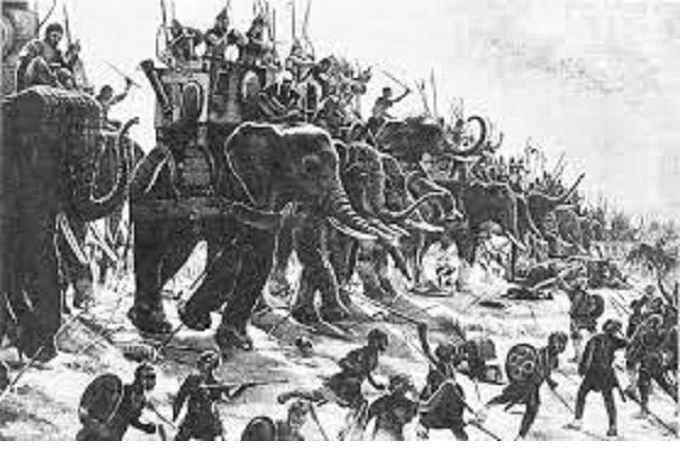How the war pigs of ancient Rome easily defeated any army

Various species of animals have been successfully domesticated and used for multiple purposes during human history. When it comes to dogs, horses, and cattle, everything is clear, but when it comes to elephants, things take on a lot more unusual turn. The human race is remarkable in its capacity for originality. Pigeons, dogs, bears, camels, and even bees have all served as military assets at various historical points. The ancient Romans took things a step further by coming up with the idea of employing a pig in war. Yes, a pig. Because Rome was so highly evolved in that area, it was able to beat any military easily.
The hidden strength of Rome
Along with the peoples of Asia, the ancient Greeks used battle elephants in their military. These huge beasts were a valuable addition in combat due to their size. Their enormous size was undoubtedly not the least of these features. The huge war machines just smashed into any enemy army, causing the soldiers of the opposing force to disperse like skittles. Those who could not get it out of the way in time were crushed to death by these huge machines.
On the other hand, there is always a means to fight back against a ploy. In this manner, it came to pass in the first half of the third century B.C. that the Romans discovered a solution. They could not only win battles against armies using fighting elephants but also send these formidable creatures into a terrified panic, which caused the elephants to trample their troops in the process.
Pigs eventually evolved into this top-secret, highly effective weapon. According to Pliny the Elder, elephants can be startled by even the smallest scream that pigs make. The Romans were the first to use pigs as fighting animals during the war. The squealing would put the elephants into such a condition of fear that they would panic and try to flee, ultimately suffocating and killing themselves. In the event that an army of war elephants besieged a Roman city, all the defenders needed to do to ensure victory was hung a couple of pigs from the city walls. It was due to the pigs that the Romans achieved their epic victory over Pyrrhus of Epirus, considered the greatest and most legendary general of all time. The idea was as simple as it could be put into action: pigs would rush headlong into the enemy ranks, causing chaos and confusion. According to Pseudo-Callisthenes’ or Alexander’s History, Macedonians initially heard of pigs as a secret weapon against Porus’s elephants.
After the battles that Justinian fought, particularly after the siege of the Mesopotamian city of Edessa in 544 AD, this practice became more widespread. In his writings, the late ancient historian Procopius provided a very detailed description of the employment of pigs by the armies of the Byzantine or Eastern Roman empires. Khosrow I of Persia waged a siege on Edessa and successfully defeated the Roman soldiers stationed there. They could not take control of the city because pigs were hanging from a tower above them. They made such a noise that the elephants began to trample the Persians, ultimately resulting in the Persian army retreating.

The elephants were eventually educated to recognize and avoid this strategy. They were taught not to be afraid of the squeal of a pig and to be comfortable when engaged in war by having elephants raised among the piglets. Because of this, the Byzantines, who were the inheritors of Roman culture, were obliged to adjust their strategy. They learned it particularly well from the hard experience of fighting against the Abbasids and the Umayyads on numerous occasions.
Fearsome battle weapon: Megara’s blazing pigs
Pigs were employed as a war weapon by more than just the Romans. Other cultures did it as well. In 266 B.C., the King of Macedonia, Antigonus II Gonatas, did the same thing. At that moment, he was dangerously close to losing the battle of Megara. Someone devised a clever plan involving dousing pigs in tar, lighting them on fire, and letting them loose on the opposing army. Naturally, the elephants reacted by running away in a terrified manner. They could put most of their army’s warriors to death by trampling on them. The consuming flames brought an end to the devastation that had been caused. Pliny and Aelian, who were both military historians, described this occurrence.

Lucretius wrote in De Rerum Natura or The Nature of Things (1st century B.C.) about these “fiery pigs”: The elephants, heated by indiscriminate murder, became mad and proved to be useless.” They managed to throw off their entire army. The big animals startled the horses, and the riders could not reassure them despite their best efforts. The elephants threw the horses and their riders to the ground, where they were trampled by the elephants’ feet. The tusks of the elephants were used to attack the horses from below, causing the horses’ flanks and abdomens to be torn open.
The use of fighting pigs was so common during that historical period that it was even inscribed on a coin that was used during that era in Rome. On one side, it had a picture of an elephant; on the other, it had a picture of a pig.
The practice has lost its power
The decrease in the use of fighting pigs coincided with the decline in the use of fighting elephants. Due to increased levels of hunting and poaching, the number of elephants in the wild was fast decreasing. In addition, human beings had been destroying the natural habitat of these animals since ancient times, which did not speak well for the expansion of their numbers either. The use of fighting elephants had nearly been completely phased out. After that, pigs were rendered entirely useless by necessity. After all, it was impossible to employ them in warfare, even to the extent of setting the enemy on fire. To begin, a pig intentionally burned to death would not make it through the ordeal. Second, there was frequently insufficient time to train the pigs properly. Because of this, they frequently caused harm to the soldiers under their command. The animals got out of control and caused much damage to their camp, which they were trying to protect.
The reliability of the sources that claimed to detail the strategies used by the fighting pigs has been called into question by a few historians. On the other hand, far too much has been written about by a wide variety of ancient chroniclers. In addition, given that elephants were an extension of the Hellenistic tradition, it is only logical that throughout the centuries, numerous tactics and countermeasures were devised to fight the overwhelming force that elephants possessed. Therefore, it’s possible that pigs were one of many such measures.




